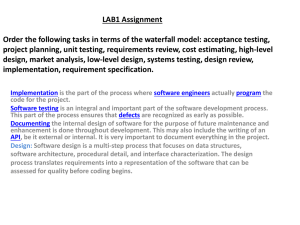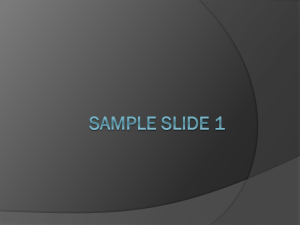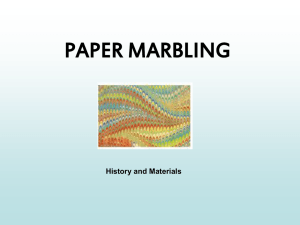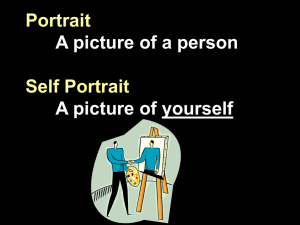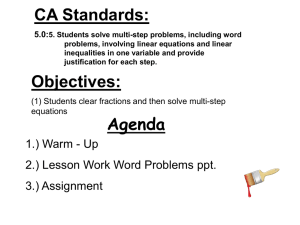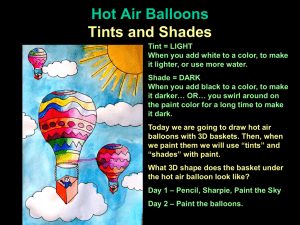2011-03-02-slides
advertisement
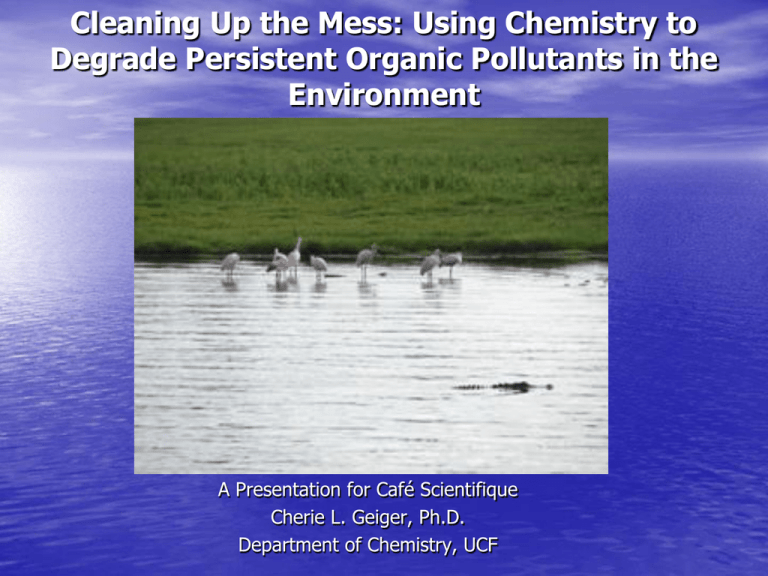
Cleaning Up the Mess: Using Chemistry to Degrade Persistent Organic Pollutants in the Environment A Presentation for Café Scientifique Cherie L. Geiger, Ph.D. Department of Chemistry, UCF Overview • What are Persistent Organic Pollutants? • Where do we come in contact with them? • Challenges in clean-up • Some new options • What is the future of environmental remediation? Persistent Organic Pollutants • Persistent organic pollutants (POPs) are organic compounds that are resistant to environmental degradation through chemical, biological, and photolytic processes. • Because of this, they have been observed to persist in the environment, to be capable of long-range transport, bioaccumulate in human and animal tissue, biomagnify in food chains, and to have potential significant impacts on human health and the environment. Examples Dichlorodiphenyl trichloroethane DDT Toxaphene Polychlorinated dibenzodioxin PCDD Dieldrin Polybrominated diphenyl ethers PBDE Chlordane Polychlorinated biphenyls PCB Aldrin Benzo(a)Pyrene WHY did we use them? • Many pollution events happened decades ago • • • before there was a good understanding of behavior of the chemicals. Many of these chemical had really GREAT properties! PCBs for example…. At one time, we wanted our chemicals to have a long half-life. More people, more of the BIG life, more pollution. Another Persistent Problem • Ground Water contamination! • Particularly important in Florida DNAPL Groundwater Contamination •Dense NonAqueous Phase Liquids •More dense than water so they sink •TCE trichloroethene •Pools •Ganglia •Sorbed •Gaseous Groundwater Contamination: Step 1 Groundwater Contamination: Step 2 Groundwater Contamination: Step 3 Groundwater Contamination: Step 4 Traditional DNAPL Remediation Techniques • Excavation • Used primarily for • contamination of heavy metals or nonvolatile compounds (ex. polychlorinated biphenyls) High cost and liability issues • Pump and Treat • Treats only dissolved • • phase compounds Would have to treat for decades High capitol and monitoring costs Bioremediation/Bioaugmentation • Initiating a population of chlorinated solvent- consuming microbes or increasing the population of such a native species • Initiating a new population is very difficult to sustain • Bioaugmentation is more attainable. Problem can be similar to KMnO4 and surfactants • Good use as a ‘polishing’ technique Zero Valent Iron Technology • Zero Valent Iron – In Permeable Reactive Barriers – Treats Dissolved Phase TCE • Reaction of Elemental Iron With Chlorinated Aliphatic: RCl + Fe + H+ => RH + Cl- + Fe+2 • Iron Alone Will Not Degrade DNAPL – Fe is Hydrophilic (water loving) – DNAPL is Hydrophobic (water hating) Permeable Reactive Barriers Treat Dissolved-Phase • http://www.powellassociates.com/sciserv/3dflow.html Zero Valent Iron Emulsion Technology • Emulsified Zero Valent Iron (EZVI) – Surfactant-stabilized, Biodegradable O/W Emulsion – Contains Nanoscale or Microscale Iron Particles Within Emulsion Droplet – Reductively Dehalogenates Chlorinated DNAPLs • Draws DNAPL Through Hydrophobic Oil Membrane • Reductive Dehalogenation Occurs on the Surface of the Iron Particle Drawing Depicting What We Envisioned Before Research Began Emulsion Composition: -corn or vegetable oil -food grade surfactant -iron particles Micrograph of Nanoscale Iron Emulsion Droplet (Approximately 12 microns in Diameter) Visual Studies Control Free Phase Iron Emulsion Success!! • Thus far, the EZVI technology has won seven national and international awards, several more regional awards. • It has been used in over twenty states and four countries. It has cleaned dozens of sites to below regulatory levels. • BTS consists of elemental magnesium coated with a small amount of palladium in a solvent solution capable of hydrogen donation (Schematic of BTS) BTS has two functions: • Extract PCBs from weathered coating or other material such as paint • Rapidly degrade the extracted PCBs via abiotic reduction in the presence of zero valent Mg or Mg/Pd Paste Formulation • Must be viscous enough to stay on vertical surface • Components: – Ethanol- hydrogen donor solvent – Limonene- paint softener – Calcium stearate, polyethylene glycol- stabilizers, thickeners – Sodium polyacrylate- absorbent (delays evaporation) – Glycerin- thickener – Mg or Mg/Pd- active particles – Acetic Acid-activator Sealant • Unsuccessful Sealants – Aluminum foil - labor intensive, susceptible to leaks – Water-based latex paint - cracks when dry – Organic-based paint - not able to retain moisture • Successful Sealants – Silicon seal – Vinyl truck bedliner – Plastic wrap Field Demonstration 1 Vertical Integration Building (VIB), Cape Canaveral Air Force Station • The Vertical Integration Building (VIB) was scheduled for • demolition when chosen for Demo in order to determine the presence, distribution, and concentrations of the PCB-containing paints, paint samples were collected from various structures within the VIB and sent to be analyzed. Concentrations of PCBs in the VIB test panels used in the demonstration ranged from ~10 to ~100 mg PCB/kg paint. Material Tested at VIB Application of BTS to VIB samples using pressurized sprayer Manual application of BTS to VIB samples. 27 Results: Field Demonstration 1 • Performance Objective Met, PCBs removed from paint to below 50 mg/kg Average of samples (2 samples at 1 week and 2 weeks and between10 and 20 samples at week 3) Field Demonstration 2 • Badger Munitions Depot, WI: Initial Pretreatment • Sampling: 56 samples were collected including painted concrete, wood and metal PCB concentrations from paint samples taken from structures range from 30 to 55,000 mg/kg Painted Surfaces 29 Application • Paste applied by hand using a trowel and on some of the treatment surfaces using a spray gun (paint sprayer) • Four locations were treated: Two concrete bunkers, metal tanks in a nitrating facility, and propellant presses in a staging area BTS applied at Badger Application Matrix: Concrete Bunker LEGEND Wk 1 Week 1 sample area Wk 2 Week 2 sample area Wk 3 Week 3 sample area VPVinyl polymer truck bed liner sealant Sil Silicon roof sealant Mg/Pd Magnesium palladium, active paste NM No metal, inactive paste Ammunition storage bunker Results from Badger • PCB concentrations in paint in concrete bunkers were • • • between ~ 1800 mg/kg to as high as 3880 mg/kg Significant reduction in PCB concentration after one week Post treatment concentration in paint after three weeks of treatment was between 96 mg/kg and 200 mg/kg Laboratory studies have demonstrated that a second application of fresh paste can get PCB levels below 50 mg/kg Average PCB Concentration (mg/kg) Results: Paint on Concrete Bunkers 6810-11 wks 0-3 Paint NM-VP 6810-11 MgPd-sil 6810-11 MgPd-VP 6810-11 3000 2500 2000 1500 1000 500 0 0 1 2 Weeks Exposure 3 4 Concentrations in paint after 1, 2 and 3 weeks exposure to BTS on concrete bunker Results: Staging Area • PCB concentrations in paint on the metals in the staging area were much lower ~ 3 mg/kg to as high as 170 mg/kg • After treatment, the concentration in the paint was between ND and 17 mg/kg. BTS was successful at extracting PCBs to below 50 mg/kg after one week PCB Concentration Paint Staging Area Presses 180 160 PCB Concentration (mg/kg) 140 120 MgPd-VP #4 100 MgPd-VP #12 80 60 MgPd-VP #14 40 MgPd-VP #15 20 0 0 0.5 1 1.5 Weeks Exposure 2 2.5 3 3.5 34 Nitrating Facility Results • PCB concentrations in paint on the metals in building 6657-02 were much higher ~10,000 mg/kg to as high as 53,000 mg/kg • Post treatment concentration in paint was between 6,600 mg/kg and 20,000 mg/kg • BTS successful at extracting PCBs but need multiple applications of BTS to treat such high starting concentrations in multiple layers of paint. Paint Concentrations: Nitrating Tank Before and After Treatment Nitrating Facility Paint PCB Concentration PCB Concentration (mg/kg) 40000 35000 30000 25000 NM-VP 20000 MgPd-sil MgPd-VP 15000 10000 5000 0 0 1 2 Weeks Exposure 3 4 Non-Active Paste: Treatment after Addition of Mg • 10 % of activated Mg added to paste after removed from painted structures and successful treatment to below 50 mg/kg even with high starting concentrations 37 BTS and Effect on PCB Transport • Concrete samples taken to evaluate whether solvent in BTS could take PCBs • from the paint into the concrete Samples taken prior to BTS application and after three weeks of BTS application at five locations Sample ID MgPd Sil 1wk concrete MgPd VP Concrete PRE-TR Conc. (mg/kg) 85 110 183 178 50 60 43 39 75 84 PRE-TR Average (mg/kg) 139 59 Post-Conc. (mg/kg) 17 16 23 17 10 37 16 15 28 14 Post-TR Average (mg/kg) 18 20 • BTS did not transfer PCBs into the concrete from the paint but actually pulled some PCBs from the concrete and treated them. 38 Acknowledgements: Thanks to ESTCP for funding this project Questions? The Group

